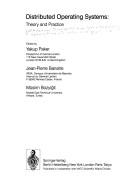| Listing 1 - 4 of 4 |
Sort by
|
Book
ISBN: 9780273088073 0273088076 Year: 1989 Publisher: London: Pitman,
Abstract | Keywords | Export | Availability | Bookmark
 Loading...
Loading...Choose an application
- Reference Manager
- EndNote
- RefWorks (Direct export to RefWorks)
Methodology --- Distributed Algorithm --- Parallelism --- Design --- Algorithms --- Algorithm Selection

ISBN: 0387176993 3540176993 3642466060 3642466044 9783540176992 Year: 1987 Volume: 28 Publisher: Berlin: Springer,
Abstract | Keywords | Export | Availability | Bookmark
 Loading...
Loading...Choose an application
- Reference Manager
- EndNote
- RefWorks (Direct export to RefWorks)
681.3*C12 --- 681.3*D41 --- Multiple data stream architectures (multiprocessors): MIMD; SIMD; pipeline and parallel processors; array-, vector-, associative processors; interconnection architectures: common bus, multiport memory, crossbar switch --- Process management: concurrency; deadlocks; multiprocessing/multiprogramming;mutual exclusion; scheduling; synchronization (Operating systems) --- 681.3*D41 Process management: concurrency; deadlocks; multiprocessing/multiprogramming;mutual exclusion; scheduling; synchronization (Operating systems) --- 681.3*C12 Multiple data stream architectures (multiprocessors): MIMD; SIMD; pipeline and parallel processors; array-, vector-, associative processors; interconnection architectures: common bus, multiport memory, crossbar switch --- Electronic data processing --- Distributed processing --- Hardware --- Formal Description --- Distributed Algorithm --- Distributed System --- Language --- Distributed
Book
ISBN: 2040157239 9782040157234 Year: 1984 Publisher: Paris: Dunod,
Abstract | Keywords | Export | Availability | Bookmark
 Loading...
Loading...Choose an application
- Reference Manager
- EndNote
- RefWorks (Direct export to RefWorks)
Parallel processing (Electronic computers) --- Electronic data processing --- Parallélisme (Informatique) --- Traitement réparti --- Distributed processing. --- Distributed processing --- -Parallel processing (Electronic computers) --- 681.3*F12 --- High performance computing --- Multiprocessors --- Parallel programming (Computer science) --- Supercomputers --- ADP (Data processing) --- Automatic data processing --- Data processing --- EDP (Data processing) --- IDP (Data processing) --- Integrated data processing --- Computers --- Office practice --- Modes of computation: alternation and nondeterminism; parallelism; probabilistic computation; relations among modes; relativized computation --- Automation --- 681.3*F12 Modes of computation: alternation and nondeterminism; parallelism; probabilistic computation; relations among modes; relativized computation --- Distributed computer systems in electronic data processing --- Distributed computing --- Distributed processing in electronic data processing --- Computer networks --- Electronic data processing - Distributed processing --- Parallelism --- Concurrent Processes --- Distributed Algorithm --- synchronization --- Concurrency
Book
ISBN: 168015897X 1282458205 1282935755 9786612458200 9786612935756 1400831474 0691141959 9780691141954 9781400831470 9781680158977 9781282458208 9781282935754 6612458208 6612935758 Year: 2009 Publisher: Princeton, NJ : Princeton University Press,
Abstract | Keywords | Export | Availability | Bookmark
 Loading...
Loading...Choose an application
- Reference Manager
- EndNote
- RefWorks (Direct export to RefWorks)
This self-contained introduction to the distributed control of robotic networks offers a distinctive blend of computer science and control theory. The book presents a broad set of tools for understanding coordination algorithms, determining their correctness, and assessing their complexity; and it analyzes various cooperative strategies for tasks such as consensus, rendezvous, connectivity maintenance, deployment, and boundary estimation. The unifying theme is a formal model for robotic networks that explicitly incorporates their communication, sensing, control, and processing capabilities--a model that in turn leads to a common formal language to describe and analyze coordination algorithms. Written for first- and second-year graduate students in control and robotics, the book will also be useful to researchers in control theory, robotics, distributed algorithms, and automata theory. The book provides explanations of the basic concepts and main results, as well as numerous examples and exercises. Self-contained exposition of graph-theoretic concepts, distributed algorithms, and complexity measures for processor networks with fixed interconnection topology and for robotic networks with position-dependent interconnection topology Detailed treatment of averaging and consensus algorithms interpreted as linear iterations on synchronous networks Introduction of geometric notions such as partitions, proximity graphs, and multicenter functions Detailed treatment of motion coordination algorithms for deployment, rendezvous, connectivity maintenance, and boundary estimation
Robotics. --- Computer algorithms. --- Robots --- Automation --- Machine theory --- Robot control --- Robotics --- Algorithms --- Control systems. --- Computer algorithms --- Control systems --- 1-center problem. --- Adjacency matrix. --- Aggregate function. --- Algebraic connectivity. --- Algebraic topology (object). --- Algorithm. --- Analysis of algorithms. --- Approximation algorithm. --- Asynchronous system. --- Bellman–Ford algorithm. --- Bifurcation theory. --- Bounded set (topological vector space). --- Calculation. --- Cartesian product. --- Centroid. --- Chebyshev center. --- Circulant matrix. --- Circumscribed circle. --- Cluster analysis. --- Combinatorial optimization. --- Combinatorics. --- Communication complexity. --- Computation. --- Computational complexity theory. --- Computational geometry. --- Computational model. --- Computer simulation. --- Computer vision. --- Connected component (graph theory). --- Connectivity (graph theory). --- Consensus (computer science). --- Control function (econometrics). --- Differentiable function. --- Dijkstra's algorithm. --- Dimensional analysis. --- Directed acyclic graph. --- Directed graph. --- Discrete time and continuous time. --- Disk (mathematics). --- Distributed algorithm. --- Doubly stochastic matrix. --- Dynamical system. --- Eigenvalues and eigenvectors. --- Estimation. --- Euclidean space. --- Function composition. --- Hybrid system. --- Information theory. --- Initial condition. --- Instance (computer science). --- Invariance principle (linguistics). --- Invertible matrix. --- Iteration. --- Iterative method. --- Kinematics. --- Laplacian matrix. --- Leader election. --- Linear dynamical system. --- Linear interpolation. --- Linear programming. --- Lipschitz continuity. --- Lyapunov function. --- Markov chain. --- Mathematical induction. --- Mathematical optimization. --- Mobile robot. --- Motion planning. --- Multi-agent system. --- Network model. --- Network topology. --- Norm (mathematics). --- Numerical integration. --- Optimal control. --- Optimization problem. --- Parameter (computer programming). --- Partition of a set. --- Percolation theory. --- Permutation matrix. --- Polytope. --- Proportionality (mathematics). --- Quantifier (logic). --- Quantization (signal processing). --- Robustness (computer science). --- Scientific notation. --- Sensor. --- Set (mathematics). --- Simply connected space. --- Simulation. --- Simultaneous equations. --- State space. --- State variable. --- Stochastic matrix. --- Stochastic. --- Strongly connected component. --- Synchronous network. --- Theorem. --- Time complexity. --- Topology. --- Variable (mathematics). --- Vector field.
| Listing 1 - 4 of 4 |
Sort by
|

 Search
Search Feedback
Feedback About UniCat
About UniCat  Help
Help News
News